You’re at White Sands National Park, a prime stargazing destination. Its vast gypsum dunes and clear skies offer a perfect stage for celestial viewing.
However, navigating this expansive park’s best stargazing spots and times can be overwhelming. Without guidance, you might miss out on the park’s full astronomical potential.
I’ll guide you through maximizing your White Sands stargazing experience in this article. From pinpointing ideal locations to choosing the best times for celestial wonders, you’ll find everything you need for a memorable night under the stars.
Key Things to Know:
- The best stargazing at White Sands is on moonless nights and in fall/winter for clear skies.
- Ideal spots are 2 miles from the entrance, on high dunes.
- Bring a red light to preserve night vision and a guide or app for star identification.
- Sledding on gypsum dunes is a unique daytime activity.
Introduction to White Sands National Park
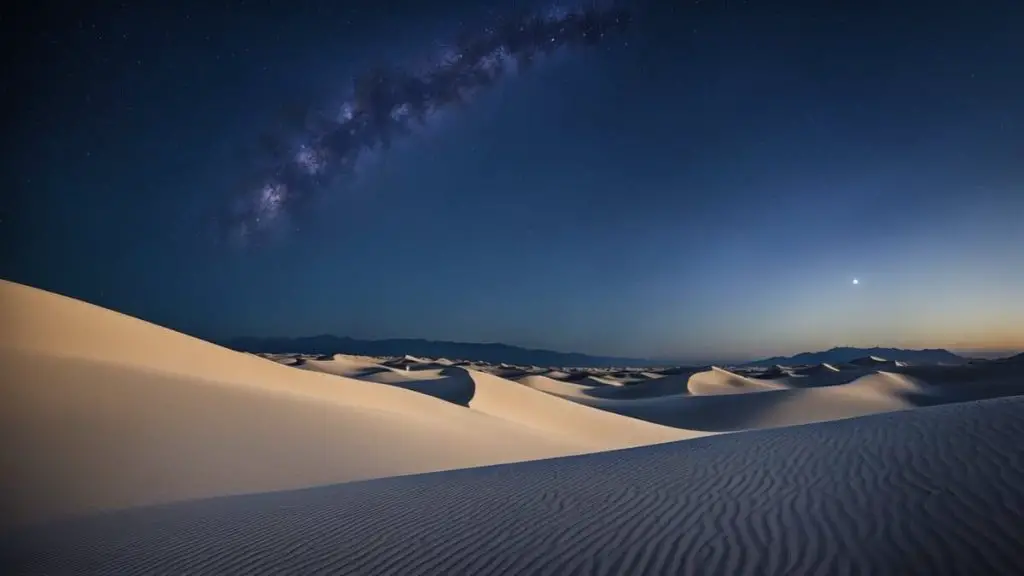
If you’re looking for an incredible stargazing destination in New Mexico, look no further than White Sands National Park. This unique park is home to the world’s largest gypsum sand dune field, covering 275 square miles of desert.
Here’s what makes White Sands National Park a must-visit location for all astronomy enthusiasts:
- The park is located in the Tularosa Basin of southern New Mexico, far from city lights and pollution, which I found enhances the clarity of the night sky.
- The gypsum sand dunes create a lunar-like landscape, providing a stunning backdrop for observing the stars.
- The park was once a national monument but was upgraded to national park status in 2019, ensuring even greater protection for this awe-inspiring area.
When I visited White Sands National Park, I marveled at the glistening white sand dunes that dominate the landscape. The park’s gypsum dunes are a rare and striking sight formed from a combination of geological processes.
Some activities you can enjoy during your visit include:
- Hiking through the dunes to find the perfect stargazing spot.
- Taking in the scenery while sledding down the soft, white sand slopes.
- Exploring the park’s diverse flora and fauna, from yuccas to roadrunners.
So, grab your telescope and head to White Sands National Park in New Mexico for an unforgettable stargazing experience!
For a complete list of the best stargazing in New Mexico, be sure to read my dedicated article.

White Sands Stargazing Overview
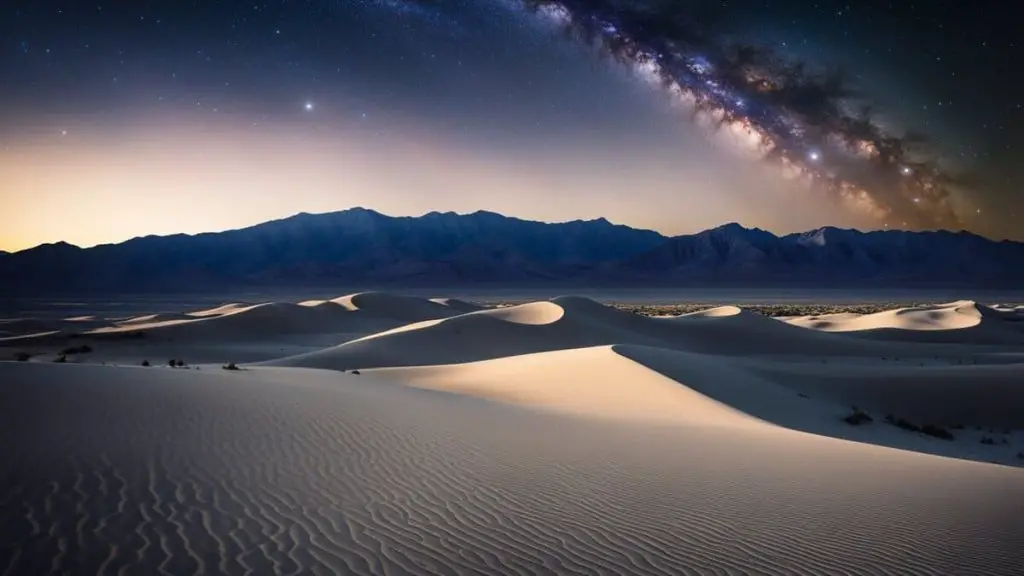
White Sands National Park provides an excellent location for stargazing, thanks to its remote location and low light pollution.
Read my article about the New Mexico Dark Sky
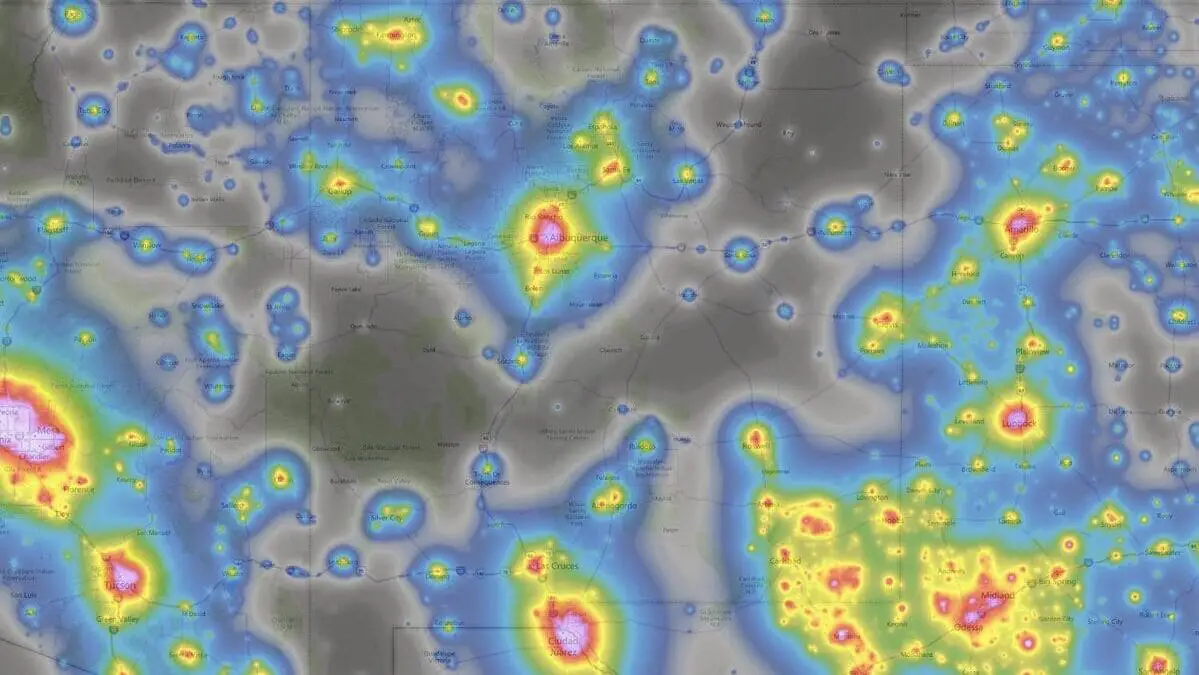
Best Times for Stargazing
The best times for stargazing at White Sands depend on what celestial objects you want to observe.
Here are some general guidelines:
- Moonless nights: To see the most stars and the Milky Way, choose a night when the moon is not visible, as its brightness can wash out fainter celestial objects. New moon nights would be ideal.
- After sunset: An hour or two after sunset will allow enough darkness for stargazing while still allowing you to enjoy the twilight colors on the dunes.
- Fall and winter months: These seasons offer longer nights and clearer skies, making them the optimal time for stargazing. However, be prepared for colder temperatures.
Observing the Night Sky
While at White Sands, there are a few things you can do to get the most out of your stargazing experience.
Here are some tips:
- Find a good spot: Venture at least 2 miles from the park entrance, away from Dunes Drive, and find a high dune with an unobstructed sky view. Check out the Backpacker article for more details.
- Give your eyes time to adjust: After arriving at your chosen spot, allow your eyes 15-20 minutes to adjust to the darkness. Avoid using white flashlights, and opt for red lights if necessary to preserve your night vision.
- Bring a stargazing guide or app: A simple guide or stargazing app helped me quickly identify the stars, planets, and constellations in the night sky. Spend some time exploring the different constellations and other celestial objects.
- Capture the night sky: If you’re into photography, this is an excellent opportunity to take stunning long-exposure images of the stars and the Milky Way.
During your stargazing adventure at White Sands National Park, you’ll undoubtedly make lasting memories as you immerse yourself in the beauty of the night sky.
FREE STARGAZING CHECKLIST
My 5-page Stargazing Checklist will enhance your astronomical observations.
Follow this free checklist to navigate the night sky with confidence, clarity, and a sense of preparedness for a rewarding stargazing experience.

Recreational Activities

Hiking Trails
White Sands National Park offers a variety of trails for you to explore its unique landscape. The Interdune Boardwalk is an easy and accessible trail, perfect for those who want to take a leisurely stroll. For a more challenging hike, try the Alkali Flat Trail, which takes you through the heart of the park’s vast dune field.
Here are some popular trails for you to choose from:
- Interdune Boardwalk: An easy, 0.4-mile, accessible trail with educational exhibits about the park’s delicate ecosystem
- Alkali Flat Trail: A moderate to strenuous 5-mile loop that offers stunning views of the gypsum dunes
- Dune Life Nature Trail: A moderate 1-mile loop that showcases various plant and animal species
- Playa Trail: A 0.5-mile easy trail that leads to a dry lakebed
- Backcountry Camping Trail: A 2-mile trail for those who want to camp overnight among the dunes
Sledding on Gypsum Dunes
One unique and fun activity you can try at White Sands is sledding down the gypsum dunes. Sand sledding is a popular activity for visitors of all ages. Grab a sand sled and experience the thrill of sliding down the soft, white dunes.
Remember to follow park guidelines and stay within designated areas for your safety.
Wildlife Watching
At White Sands National Park, you can observe various animal species that thrive in this extraordinary ecosystem.
While exploring the park, look out for animals like the elusive pupfish that adapted to survive in this harsh environment.
You can spot wildlife along the Dune Life Nature Trail or the Playa Trail. Just follow the trail markers so you don’t get lost.
Planning Your Visit
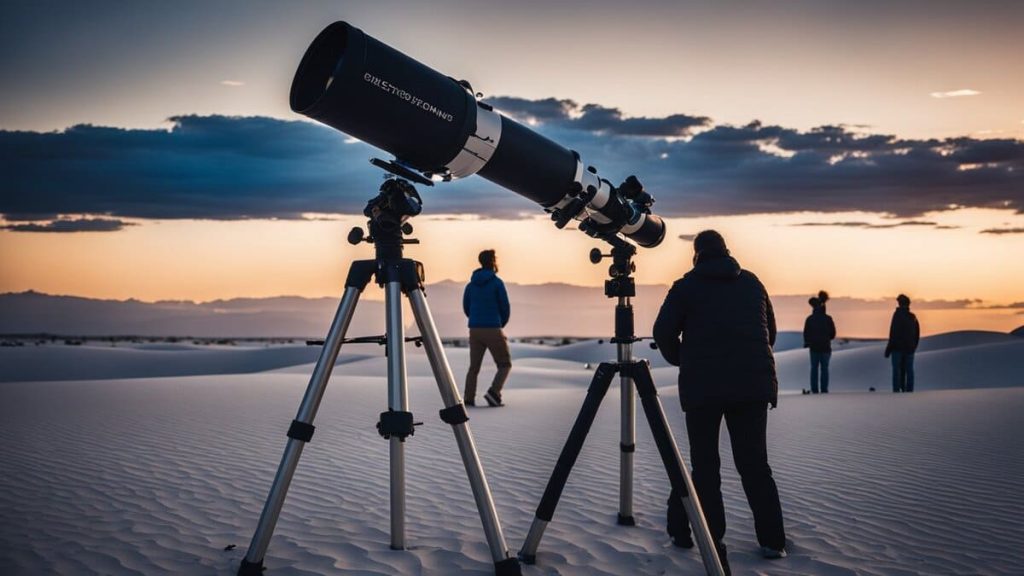
Travel and Accommodation
To plan your White Sands stargazing trip, consider your travel options.
The nearest major city is Las Cruces, about an hour’s drive away, and El Paso, Texas, is about 1.5 hours away. The closest airport is in El Paso, making it a convenient starting point for a road trip.
There are plenty of accommodation options in both Las Cruces and Alamogordo. Some popular choices include the Hotel Encanto de Las Cruces and various chain hotels in Alamogordo.
When visiting White Sands, remember:
- Rent or drive your own vehicle, as public transportation options are limited.
- Book your accommodations in advance, whether you prefer a hotel or camping.
Permits and Safety
White Sands National Park has specific operating hours that vary by season.
Check the park’s website for up-to-date hours and plan your visit accordingly. Alcohol is prohibited in the Evening Program Area except during special events.
It’s essential to be aware of potential missile testing in the area, as it can result in temporary closures.
When visiting, ensure you:
- Obtain the necessary permits for your preferred activities.
- Stay informed about park closure announcements.
- Follow all safety guidelines provided by the park staff.
Visitor Center and Ranger Programs
On my visit, the Visitor Center at White Sands National Park offered me helpful information and resources for planning my stargazing trip.
The center provides details on nearby attractions, accessibility, and safety tips. Check out the ranger programs to enhance your experience and learn more about the unique landscape and night sky.
To make the most of your trip, don’t forget to:
- Visit the park’s visitor center for information and resources.
- Attend ranger-led programs for a guided stargazing experience.
Seasonal Considerations

Summer Heat and Activities
During my summer visit to White Sands National Park, I experienced the intense heat, so it’s crucial to plan your trip accordingly.
During the day, temperatures can reach well over 100°F, which might not be the most comfortable environment for many people. Consider planning your visit during the early morning or late evening hours to avoid the heat.
Aside from stargazing, you can also enjoy activities like:
- Hiking or walking through the dunes
- Sledding down the sandy slopes
- Taking a scenic drive through the park
- Attending ranger-led programs
Remember to stay hydrated during your summer visit and wear appropriate clothing to protect yourself from the sun.
Fall Adventures
As the temperatures cool down in the fall, White Sands National Park becomes an ideal destination for daytime exploration and nighttime stargazing.
During this season, you may find the following activities enjoyable:
- Backcountry camping: Fall is an excellent time to explore the park’s backcountry and camp under the stars. You’ll need a permit for backcountry camping, so be sure to plan ahead.
- Early entry or late stay: Make the most of your visit by arriving early or staying late to appreciate the park’s natural beauty during dusk and dawn.
- Camping nearby: If you prefer to camp outside the park, several campgrounds in the surrounding area offer a convenient and comfortable stay.
Keep in mind that nights in the desert can get cold, even in the fall. So, be prepared with warm clothing and gear for your White Sands stargazing experience.
Conservation Efforts
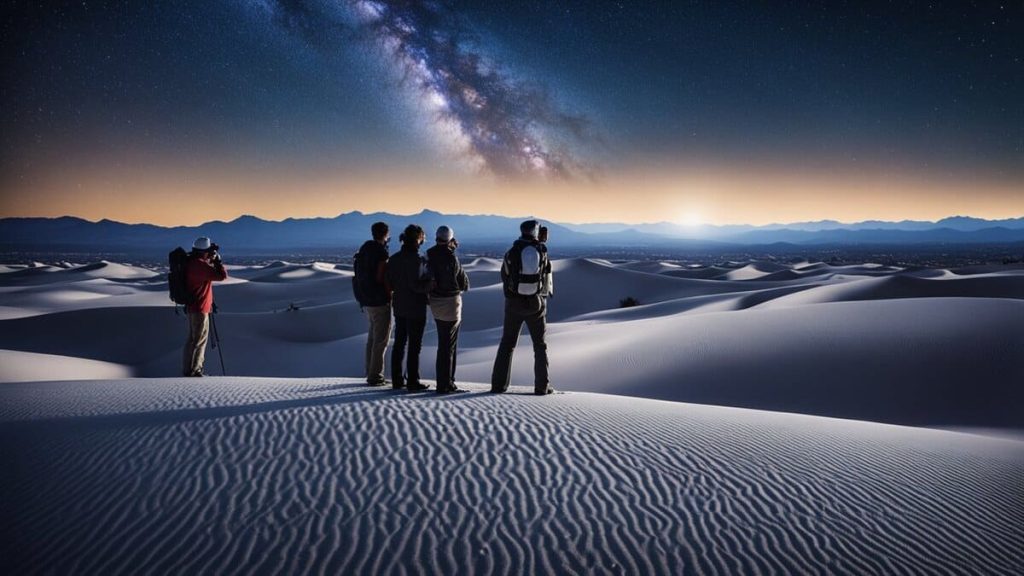
At White Sands National Park, preserving the area’s unique ecosystem and natural beauty is a top priority. This includes protecting its plants and animals and the white gypsum sands that create this mesmerizing landscape. Several conservation efforts are in place to ensure the park remains unimpaired for future generations to enjoy.
One critical effort in conservation is maintaining the delicate balance within the park’s ecosystem.
Here are a few measures taken to preserve this balance:
- Resource Management: The park’s Sustainability program ensures that natural resources, such as water and energy, are used efficiently and responsibly without compromising the environment.
- Native Species Protection: White Sands is home to unique plants and animals, many specially adapted to survive in this extreme desert environment. Park staff work to protect these species and their habitats from threats like invasive species and human disturbances.
- Community Engagement: Educating visitors and involving them in conservation efforts is essential for long-term preservation. The park offers various programs, like guided tours and Junior Ranger programs, which I found insightful for learning about protecting the park’s resources.
By participating in conservation efforts, you can help ensure the stunning beauty of White Sands National Park remains intact for generations of stargazers to appreciate.
Remember to follow park guidelines and leave no trace of your visit, ensuring that the unique ecosystem, plants, animals, and breathtaking landscape continue to thrive.
Cultural and Historical Significance
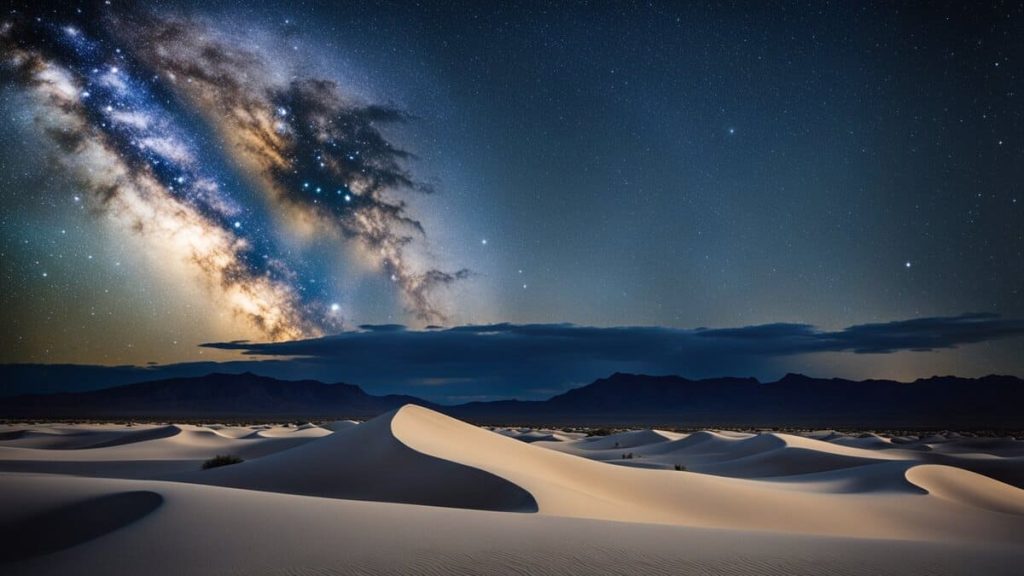
The Tularosa Basin, where White Sands National Park is located, has a rich cultural and historical significance. Various groups, including the Mescalero Apaches and Hispanic New Mexicans, have called this area home for centuries. You discover remnants of their presence across the vast desert landscape. as you explore the area.
White Sands has also played a vital role in the development of modern technology. The park is adjacent to the White Sands Missile Range, which has been home to many important events in the history of science.
It’s here that the world’s first atomic bomb was tested at the famous Trinity Test Site. This event changed the course of history and shaped the modern world as we know it today.
When planning your stargazing trip to White Sands, take note of these significant locations within the park:
- The world’s largest gypsum dune field
- The Tularosa Basin, filled with iconic historical landmarks
- Trinity test site, the birthplace of the atomic bomb
As you stargaze under the beautiful and unobstructed night sky, remember standing in a location steeped in history. The combination of natural beauty and cultural significance makes White Sands a truly unique destination for astronomy enthusiasts like you.
Unique Features and Geography
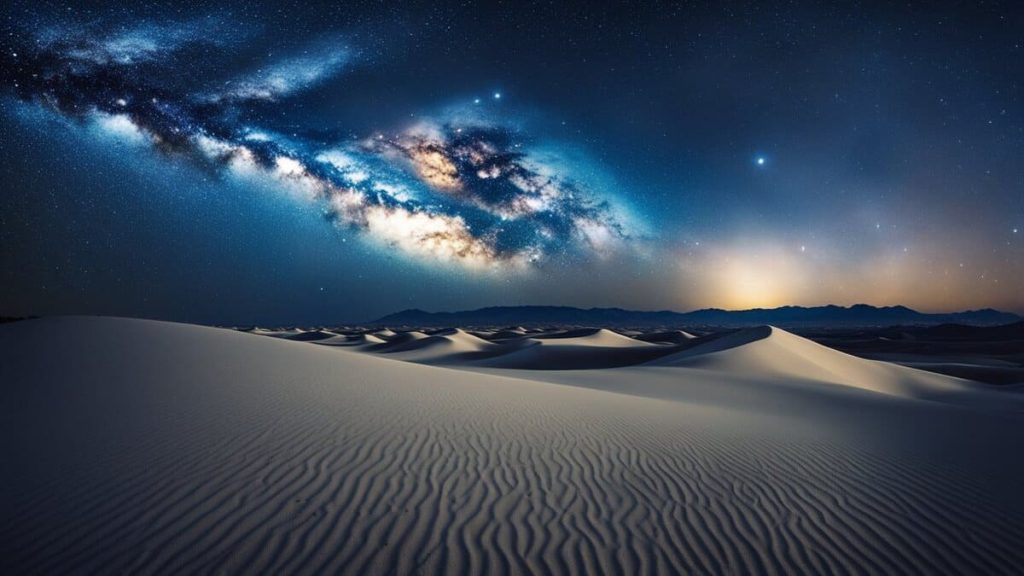
White Sands National Park, located in southern New Mexico, is well-known for its gypsum sand dunes. These dunes create a mesmerizing and otherworldly landscape that’s perfect for stargazing. The white gypsum dunes provide an awe-inspiring backdrop for the night skies while being surrounded by desert and mountains.
When I explored the dunes of White Sands, I realized they are not just your average sand dunes. In fact, they are the world’s largest gypsum dune field!
Gypsum is typically a soft mineral that dissolves in water. However, in White Sands, the unique desert conditions allowed the formation of 275 square miles of pristine dunes made of gypsum sand.
Here is a list of some unique characteristics:
- Gypsum sand dunes
- Largest gypsum dune field in the world
- Surrounded by desert and mountains
I found the unique geography of White Sands truly captivating during my visit. Besides the massive dunes, the park is situated in a basin with several mountain ranges surrounding the area. This creates a natural buffer, protecting the dark skies for an ideal stargazing experience.
Take note of the following tips for enjoying the unique landscape:
- Bring proper gear for walking on the sand dunes, like comfortable shoes and sun protection.
- Stick to marked trails to preserve the delicate dune environment and avoid getting lost.
- Pack a portable telescope or binoculars for an up-close view of the stars in the night sky.
In summary, the unique features and geography of White Sands National Park blend together to make it an unbeatable destination for stargazing. The vast gypsum dunes, the world’s largest gypsum dune field, and picturesque desert and mountains create an unforgettable experience that you won’t want to miss.
Special Events and Programs
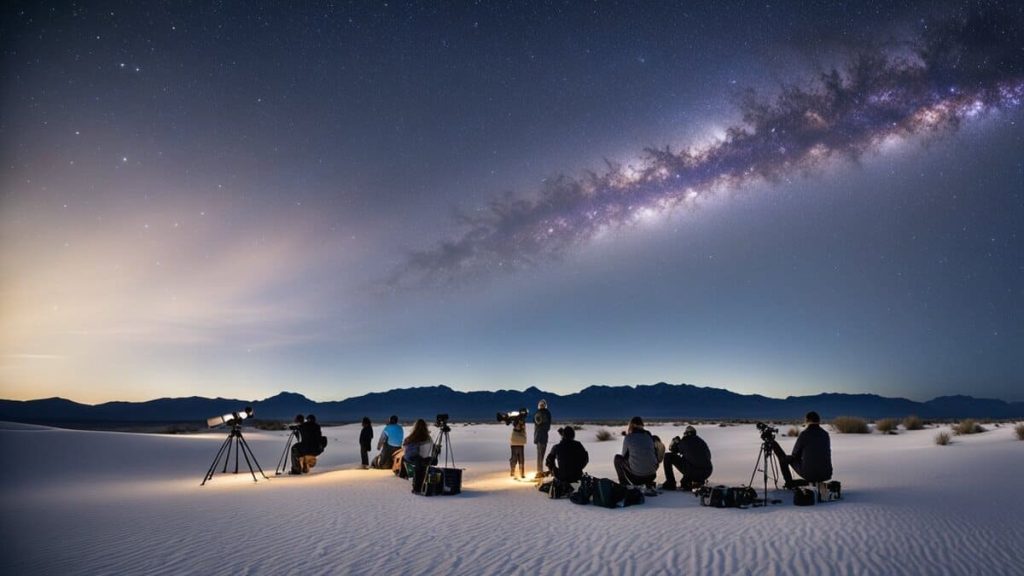
At White Sands National Park, various special events and programs allow you to experience stargazing like never before. These events cater to all, regardless of astronomy knowledge, providing an unforgettable experience under the clear, dark skies.
One exciting opportunity at the park is the White Sands Star Party. This annual event invites registered participants and their families to gaze at the stars and even camp in the unique environment of the world’s largest gypsum dune field. It truly is a once-in-a-lifetime experience.
You can attend monthly ranger-guided programs to make your stargazing experience even more memorable. These programs teach you:
- The basics of stargazing
- How to identify specific celestial objects
- Fun astronomy facts
Another popular event is the Open House, where visitors can gather and interact with park rangers and experienced stargazers. This event is an excellent opportunity to learn from others, ask questions, and further develop astronomy knowledge.
Lastly, when visiting White Sands National Park, don’t forget to take a drive along Dunes Drive, which offers a scenic route through the heart of the park and is the primary access point for the Visitor Center. Make sure to grab your camera, as the views along the way are truly breathtaking!
Frequently Asked Questions
Can I participate in any organized stargazing events at White Sands?
Yes, White Sands National Park often hosts organized stargazing events, such as the annual White Sands Star Party. These events provide guided observations of the night sky and are great for both beginners and experienced astronomers.
Is there any specific equipment I should bring for stargazing at White Sands?
For the best stargazing experience at White Sands, bring a telescope or binoculars for a closer look at celestial objects. Additionally, packing a star chart or using a stargazing app can enhance your ability to identify stars and constellations.
Are there any safety concerns I should be aware of while stargazing at White Sands?
While stargazing at White Sands, be aware of the park’s nocturnal wildlife and varying temperatures. It’s crucial to stay on designated trails to avoid disturbing wildlife and to dress appropriately for cooler night temperatures, even in summer.
TL;DR
- White Sands National Park in New Mexico offers exceptional stargazing opportunities due to its remote location and clear, dark skies.
- Best viewing times are moonless nights and during the fall and winter months, with ideal spots located 2 miles from the entrance on high dunes.
- Essential items for a night of stargazing include a red light for night vision, a stargazing guide or app, and appropriate cold-weather clothing.
- Daytime activities include hiking, sledding on the unique gypsum dunes, and wildlife watching.
- The park hosts special events and programs for an enhanced stargazing experience, and conservation efforts are crucial for preserving its natural beauty.
Your thoughts and questions are invaluable to me as I continue to explore the wonders of stargazing. Whether you’re a seasoned astronomer or starting out, I’m here to share insights and learn alongside you.
Please leave your questions or comments below – let’s start a stellar conversation!




